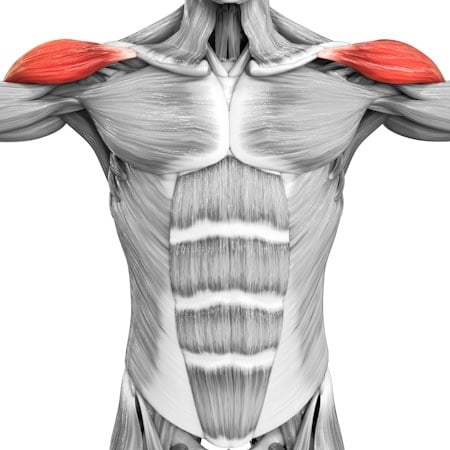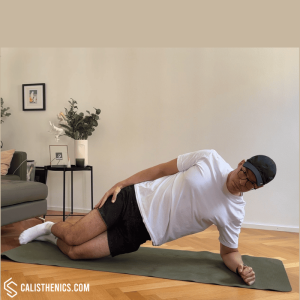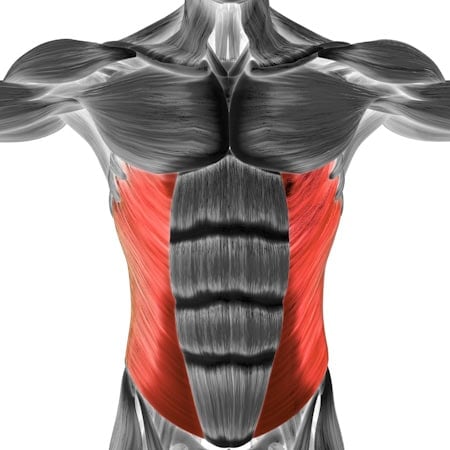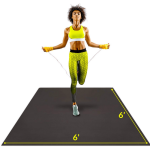Knee Side Plank
How to do Knee Side Plank?
The knee side plank is a modified version of the traditional side plank, where your knees remain on the ground instead of your feet. This variation is ideal for beginners or individuals recovering from injury, as it reduces the load on the core and shoulders while still effectively targeting the obliques, hips, and glutes. The knee side plank helps improve core stability, balance, and strength while being easier on the body compared to the full side plank.
Steps to Perform a Proper Knee Side Plank
1. Starting Position (on Knees):
• Begin by lying on your side with your knees bent at a 90-degree angle and stacked on top of each other. Position your forearm directly beneath your shoulder, with your elbow aligned with your body.
• Your forearm should be perpendicular to your body, and your legs should remain together, with your knees on the ground.
2. Engage Your Core and Lift Your Hips:
• Tighten your core and glutes as you lift your hips off the ground. Your body should form a straight line from your shoulders to your knees, with your upper body supported by your forearm and lower body by your knees.
• Keep your hips stacked and your neck in line with your spine by looking straight ahead.
3. Hold the Position:
• Hold the side plank position for the desired amount of time, focusing on keeping your hips lifted and your core engaged to maintain proper form.
• You can place your free hand on your hip for balance or extend it toward the ceiling to increase the challenge.
4. Lower and Repeat:
• After holding the position for your goal time, gently lower your hips back to the ground. Switch sides and repeat on the other side for a balanced workout.
Benefits of Knee Side Planks
• Strengthens the Core: Knee side planks effectively target the obliques and core muscles, helping to build strength and stability in the midsection.
• Improves Hip Stability: By engaging the glutes and hip abductors, knee side planks help improve hip stability, which is essential for balance and movement efficiency.
• Reduces Lower Back Pain: Strengthening the obliques and core muscles helps reduce the risk of lower back pain by providing better support to the spine.
• Promotes Better Balance: Side planks, even on the knees, improve balance and coordination by engaging multiple stabilizing muscles throughout the body.
• Low Impact: This variation is gentle on the joints, making it an excellent option for individuals recovering from injury or those who have joint issues.
• Prepares for Full Side Plank: The knee side plank is a stepping stone to the full side plank, allowing beginners to build strength and progress at a manageable pace.
• Enhances Postural Control: Strengthening the core, hips, and shoulders improves overall posture and body alignment, which benefits daily movements and athletic performance.
Tips for the proper execution of Knee Side Plank
Engage Your Core: Keep your core tight throughout the exercise to stabilize your body and prevent your hips from sagging.
Maintain a Straight Line: Ensure your body forms a straight line from your shoulders to your knees. Avoid letting your hips drop or rotate.
Shoulder Alignment: Your shoulder should be directly above your elbow to avoid straining your shoulder joint.
Controlled Breathing: Breathe steadily throughout the movement. Inhale deeply through your nose and exhale through your mouth to help stabilize your core and prevent fatigue.
Muscles worked when doing Knee Side Plank
Primary Muscles:
•Obliques: The primary muscles targeted by the knee side plank. These muscles help stabilize the spine and prevent side-to-side bending.
•Glutes: Engaged to support hip stability and assist with lifting and holding the hips off the ground.
•Hip Abductors: Including the gluteus medius, which helps stabilize the pelvis during the movement.
Secondary Muscles:
•Core: The abdominal muscles, including the rectus abdominis and transverse abdominis, work to stabilize the torso.
•Shoulders: Anterior deltoids and rotator cuff muscles help stabilize the upper body while supporting the plank.
•Lower Back: Erector spinae muscles help maintain a straight body position.
•Quadriceps: Engaged to help stabilize the lower body.
Primary Muscle(s):
Secondary Muscle(s):

Lateral delt
Adjust the difficulty of Knee Side Plank
How to make Knee Side Plank harder?
How to make Knee Side Plank easier?
How to make Knee Side Plank harder?
To make Knee Side Plank harder:
-
Extend the Top Leg: Keep your bottom leg bent and lift your top leg straight up, extending it fully. This increases the challenge by engaging your hip abductors and core more intensely.
-
Increase the Duration: Hold the side plank for longer periods, such as 30-60 seconds or more, to challenge your endurance and core stability.
-
Add a Leg Lift: While holding the knee side plank, lift your top leg a few inches off the ground and lower it back down in controlled repetitions to further engage your glutes and core.
-
Add Resistance: Use a resistance band around your thighs or place a small weight on your hip to increase the intensity of the exercise.
How to make Knee Side Plank easier?
To make Knee Side Plank easier:
-
Reduce the Duration: Start with shorter holds, such as 10-15 seconds, and gradually increase as your core strength improves.
-
Use a Cushion: If you find it uncomfortable to rest on your knees, use a cushion or soft mat under your knees for added comfort and support.




